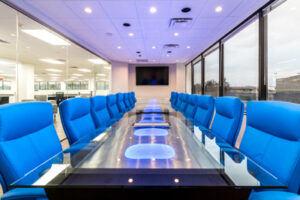The World and Workforce is Changing. Build a Modern Workplace.
Part 2: Rethink Form and Function
 The modern workforce is changing, with greater value placed on flexibility and meaningful work. To attract and retain top talent, companies need to rethink the workspace they offer employees. An engaging workplace motivates employees to do their best work, resulting in increased productivity.
The modern workforce is changing, with greater value placed on flexibility and meaningful work. To attract and retain top talent, companies need to rethink the workspace they offer employees. An engaging workplace motivates employees to do their best work, resulting in increased productivity.
Designing a modern workplace requires research and planning – determining what your employees value and finding the best way to provide that. Don’t spend a fortune on couches and a ping pong table for the lounge when what your employees really desire is more natural light and better acoustics. Spend your time and money wisely by focusing on the key needs of the workplace: a home for your business, a toolkit for your employees, and a connection to the culture of your business.
What Employees Want
The State of Work in America study found that more than half of respondents would give up a 10 to 20% salary increase for a more flexible work schedule. Knowing that flexibility is one of the most valued attributes of a job, company owners need to consider how to provide a workplace that embraces this concept. There is a compromise between working remotely and being present in the office that works for both employers and employees. Companies that respect this balance will be better positioned to attract and retain talent.
“The first step in creating a productive workspace is focusing of form and function. How does your team use the space on a daily basis?” says Nathan Maurer, President of COCRE8 Office Interiors, who offers three scenarios for clients to consider.
- 80/20 Workspace: In this workplace, employees are in their personal workspace 80 percent of the time and using collaborative space 20 percent of the time.
- 50/50 Workspace: In this workplace, employees put equal importance on individual and collaborative space.
- 20/80: This less common workplace is for a company with employees who primarily work remotely and are only in the office once or twice a week. The space is used mainly for bringing the team together and not for personal workspace.
Maurer suggests that companies work directly with employees to identify what they desire in the workplace. The process may include interviewing key team leaders within an organization or asking employees to complete a questionnaire. These findings help guide the plan for the space.
Design Process
Business owners typically work in tandem with architects and designers for any office design project, whether it is a simple refresh of the space or a full tear down. These experts help guide companies through the most effective and efficient design solutions, suggesting everything from space planning and reconfiguration to furnishings and finishes.
“Our clients want to focus on running their business. They don’t have the vision, resources, or time to do this. We understand the process and detail required for a successful office design,” says Maurer.

An office design firm also has the product knowledge and access to goods needed to meet the specific needs of any business. These experts help find solutions to various workplace issues, whether you need ergonomic furniture, improved airflow, climate control, or enhanced lighting.
“Every space is different. Every need is different. We represent more than 200 manufacturers and we are able to offer options to meet the aesthetics, function, and price point needed by our clients,” says Maurer.
Providing the Ideal Work Environment
While there is no one size fits all approach to office design, all companies benefit by focusing on how they treat employees. Are you valuing the same things that employees value, including flexible work weeks, competitive compensation, and a supportive workplace culture?
“The old school thought process is out the window. Managers don’t want to be in offices isolated from their team. Employees don’t want to spend 60 hours a week at the office. Once you embrace that the modern workplace is vastly different you can stay competitive in the labor market and in increase productivity,” says Maurer.
To successfully design a productive workspace, the process must be a collaborative effort among company leaders, employees, and design experts. The completed work environment should be cost-effective, appealing, functional, and reflect your organization’s culture. The goal is to provide a work environment that champions creativity, innovation, and teamwork – the kind of workplace today’s best and brightest are seeking.
Part One: Change Your Mindset discussed the importance of entering into the design process with an open mind and being willing to evolve with employee needs. Check it out Here.
